Leucaugines
Dimitar Dimitrov and Gustavo Hormiga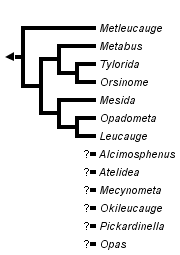


This tree diagram shows the relationships between several groups of organisms.
The root of the current tree connects the organisms featured in this tree to their containing group and the rest of the Tree of Life. The basal branching point in the tree represents the ancestor of the other groups in the tree. This ancestor diversified over time into several descendent subgroups, which are represented as internal nodes and terminal taxa to the right.

You can click on the root to travel down the Tree of Life all the way to the root of all Life, and you can click on the names of descendent subgroups to travel up the Tree of Life all the way to individual species.
For more information on ToL tree formatting, please see Interpreting the Tree or Classification. To learn more about phylogenetic trees, please visit our Phylogenetic Biology pages.
close boxIntroduction
Leucaugines are a very species-rich group which includes some of the most beautiful tetragnathid spiders. Many leucaugines are relatively large and have vivid colors and reflective silvery abdominal patterns. Leucaugines are most diverse in the tropics but some genera have representatives in the temperate zones. Some leucaugines are very common and well known, such as the orchard spider (Leucauge venusta), a species widely distributed in the Americas.
The subfamily Leucauginae was created by Caporiacco (1955) to include four Leucauge species from Venezuela. Leucaugines have traditionally been included within the “metine’’ tetragnathid lineages.
Characteristics
All leucaugines have two rows of long feathered trichobothria on the leg femora which often can be seen with the naked eye. Males are usually almost the same size as females and, unlike in other tetragnathids, cheliceral sexual dimorphism is not conspicuous. In addition, the male pedipalps of leucaugines have a dorso-basal cymbial process and a mesally displaced tegulum. The embolus has a large base, at least twice longer than wide, and the sperm duct path is complex with more than two coils.

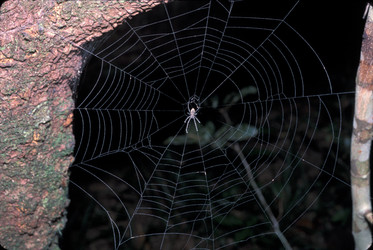
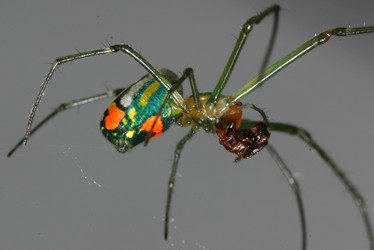
Left: Tylorida sp. © 2006 Gustavo Hormiga Right: Leucauge venusta. © 2008 Chuck
Most leucaugines build two-dimensional orb-webs that can vary considerably in the number of spiral turns and radii even between individuals of the same species. In some Leucauge species the webs have a tree dimensional barrier structure.

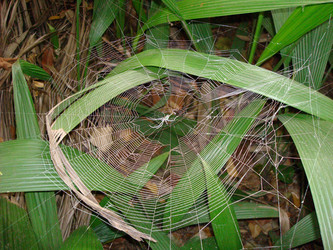
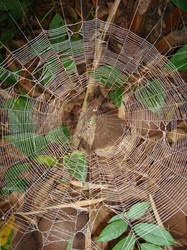
Leucauge venusta webs. © 2007 Gustavo Hormiga
Discussion of Phylogenetic Relationships
Several cladistic analyses have corroborated the monophyly of leucaugines (Álvarez-Padilla, 2007; Álvarez-Padilla et al., 2009; Dimitrov and Hormiga, 2009; Tanikawa, 2001). The tree presented here is based on the morphological and molecular analysis of Álvarez-Padilla et al. (2009).
The following tetragnathid genera have at lest some of the synapomorphies of Leucauginae (but not have been included in any analyses): Alcimosphenus, Atelidea, Mecynometa, Okileucauge, Opas and Pickardinella. These genera are listed here as incertae sedis.
References
Álvarez-Padilla F., Dimitrov D., Giribet G., Hormiga G. 2009. Phylogenetic relationships of the spider family Tetragnathidae (Araneae, Araneoidea) based on morphological and DNA sequence data. Cladistics (In press).
Álvarez-Padilla F. 2007. Systematics of the spider genus Metabus O. P.-Cambridge, 1899 (Araneoidea: Tetragnathidae) with additions to the tetragnathid fauna of Chile and comments on the phylogeny of Tetragnathidae. Zool. J. Linn. Soc. 150: 285–335.
Caporiacco L.di. 1955. Estudios sobre los arácnidos de Venezuela. 2a parte: Araneae. Acta Biol. Venez. 1: 265–448.
Dimitrov D., Hormiga G. 2009. Revision and cladistic analysis of the orbweaving spider genus Cyrtognatha Keyserling, 1881 (Araneae, Tetragnathidae). Bulletin of the American Museum of Natural History 317: 1-139.
Tanikawa A. 2001. Okileucauge sasakii, a new genus and species of spider from Okinawajima Island, southwest Japan (Araneae, Tetragnathidae). J. Arachnol. 29: 16–20.
Title Illustrations

| Scientific Name | Leucauge sp. |
|---|---|
| Location | Costa Rica |
| Specimen Condition | Live Specimen |
| Identified By | Gustavo Hormiga |
| Image Use |
 This media file is licensed under the Creative Commons Attribution-NonCommercial License - Version 3.0. This media file is licensed under the Creative Commons Attribution-NonCommercial License - Version 3.0.
|
| Copyright |
© Gustavo Hormiga

|
| Scientific Name | Leucauge venusta |
|---|---|
| Location | Houston, Texas, USA |
| Specimen Condition | Live Specimen |
| Source | Front Door Spider I |
| Source Collection | Flickr |
| Image Use |
 This media file is licensed under the Creative Commons Attribution-NonCommercial-NoDerivs License - Version 2.0. This media file is licensed under the Creative Commons Attribution-NonCommercial-NoDerivs License - Version 2.0.
|
| Copyright | © 2007 Chuck |
About This Page
Dimitar Dimitrov

Zoological Museum, University of Copenhagen
Gustavo Hormiga

George Washington University, Washington, D. C., USA
Correspondence regarding this page should be directed to Dimitar Dimitrov at and Gustavo Hormiga at
Page copyright © 2009 Dimitar Dimitrov and Gustavo Hormiga
 Page: Tree of Life
Leucaugines.
Authored by
Dimitar Dimitrov and Gustavo Hormiga.
The TEXT of this page is licensed under the
Creative Commons Attribution-NonCommercial License - Version 3.0. Note that images and other media
featured on this page are each governed by their own license, and they may or may not be available
for reuse. Click on an image or a media link to access the media data window, which provides the
relevant licensing information. For the general terms and conditions of ToL material reuse and
redistribution, please see the Tree of Life Copyright
Policies.
Page: Tree of Life
Leucaugines.
Authored by
Dimitar Dimitrov and Gustavo Hormiga.
The TEXT of this page is licensed under the
Creative Commons Attribution-NonCommercial License - Version 3.0. Note that images and other media
featured on this page are each governed by their own license, and they may or may not be available
for reuse. Click on an image or a media link to access the media data window, which provides the
relevant licensing information. For the general terms and conditions of ToL material reuse and
redistribution, please see the Tree of Life Copyright
Policies.
- First online 09 March 2009
- Content changed 09 March 2009
Citing this page:
Dimitrov, Dimitar and Gustavo Hormiga. 2009. Leucaugines. Version 09 March 2009 (under construction). http://tolweb.org/Leucaugines/134640/2009.03.09 in The Tree of Life Web Project, http://tolweb.org/




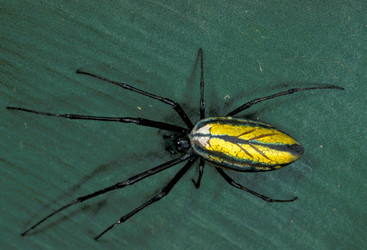
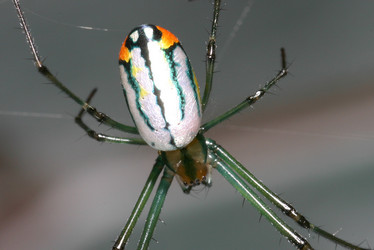
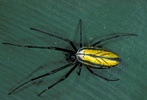
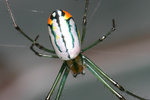

 Go to quick links
Go to quick search
Go to navigation for this section of the ToL site
Go to detailed links for the ToL site
Go to quick links
Go to quick search
Go to navigation for this section of the ToL site
Go to detailed links for the ToL site